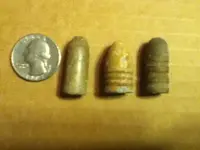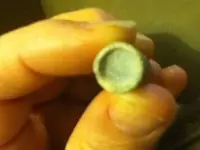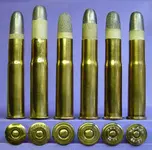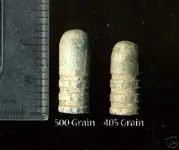✅ SOLVED What type bullets?
- Thread starter rcumbee64
- Start date
Breezie
Gold Member
- Joined
- Oct 3, 2009
- Messages
- 6,269
- Reaction score
- 2,119
- Golden Thread
- 1
- Location
- North Carolina
- 🥇 Banner finds
- 1
- Detector(s) used
- White's DFX & Spectrum~Garrett's Pro-Pointer~VibraProbe
- Primary Interest:
- Metal Detecting
Hopefully the CBG and other bullet experts will be in to help you, but in the meantime, the 1st one looks like an Civil War era Enfield (it could be a Pickett depending on the length,) the 2nd a Civil War era 3-ring Minie, and the last one looks like a modern day bullet. WELCOME to the forum from the non-bullet person,  Breezie
Breezie
PS: Before the bullet folks arrive, you might as well measure the diameter of the base so the correct caliber can be determined. Also look up into the base of the Enfield to see if there is a symbol or letter.
 Breezie
BreeziePS: Before the bullet folks arrive, you might as well measure the diameter of the base so the correct caliber can be determined. Also look up into the base of the Enfield to see if there is a symbol or letter.
Last edited:
Upvote
0
duggap
Bronze Member
- Joined
- Dec 11, 2007
- Messages
- 2,055
- Reaction score
- 1,053
- Golden Thread
- 0
- Location
- Chattanooga, TN
- Detector(s) used
- Tosoro Bandido
- Primary Interest:
- Metal Detecting
Breezie I agree with you but I have my doubts about the first one. If the middle one is a 58, which I believe it is, then the one on the right would have to be in the forties for calabre. I would have to hold it to be sure. It could be old, I just don't recognize it.
Upvote
0
tennessee digger
Bronze Member
I agree with Breezie. The first looks to be an Enfield pattern (there were many varieties) next looks like a .58 and last one is old but considered modern. Good job Breezie. Tennessee digger
Upvote
0
rcumbee64
Jr. Member
- Joined
- Jan 21, 2013
- Messages
- 30
- Reaction score
- 3
- Golden Thread
- 0
- Primary Interest:
- All Treasure Hunting
- #5
Thread Owner
Thanks for the welcome! I have been detecting for years and yet just discovered this awesome site!
The Enfield is 1 1/8 inches in length diameter is 1/2 inch with a "W" in the end.
Minis is 1 inch in length and diameter is 5/8
Last bullet is 1 1/8 in length and diameter is 1/2
The Enfield is 1 1/8 inches in length diameter is 1/2 inch with a "W" in the end.
Minis is 1 inch in length and diameter is 5/8
Last bullet is 1 1/8 in length and diameter is 1/2
Upvote
0
- Joined
- Mar 5, 2010
- Messages
- 7,663
- Reaction score
- 12,429
- Golden Thread
- 0
- Location
- Southwest Georgia
- Detector(s) used
- XP Deus, White's DFX
- Primary Interest:
- All Treasure Hunting
am also NOT a bullet expert but I don't think the first one is an Enfield. Can you post a picture of the base?
Upvote
0
EccentricInTexas
Hero Member
- Joined
- Jan 14, 2013
- Messages
- 944
- Reaction score
- 659
- Golden Thread
- 0
- Location
- Central Texas
- Detector(s) used
- Minelab Equinox 800 11DD coil 11x15DD coil 6DD coil
Schiebel AN-19/2,
Bounty Hunter Land Ranger Pro,
Bounty Hunter Pioneer 505,
- Primary Interest:
- All Treasure Hunting
First one looks like a Paper Patch bullet, second one is a minie Ball, and the third one could be for a 45-70 or 50-70 hard to tell with out accurate measurements. The third one is also hard to date since that same pattern is still in use today for many lead cast bullets. But due to the length it is almost certainly a rifle round and not a pistol bullet.
Upvote
0
EccentricInTexas
Hero Member
- Joined
- Jan 14, 2013
- Messages
- 944
- Reaction score
- 659
- Golden Thread
- 0
- Location
- Central Texas
- Detector(s) used
- Minelab Equinox 800 11DD coil 11x15DD coil 6DD coil
Schiebel AN-19/2,
Bounty Hunter Land Ranger Pro,
Bounty Hunter Pioneer 505,
- Primary Interest:
- All Treasure Hunting
Using your measurements the first one is .4375 so it was probably a .45 caliber paper patched round. the second is .625; .62 caliber the third is .375; .38 caliber could be any number of rounds.
Upvote
0
TheCannonballGuy
Gold Member
- Joined
- Feb 24, 2006
- Messages
- 6,606
- Reaction score
- 13,446
- Golden Thread
- 0
- Location
- Occupied CSA (Richmond VA)
- Detector(s) used
- White's 6000, Nautilus DMC-1, Minelab
- Primary Interest:
- Relic Hunting
The bullet at right is definitely a .45-70 bullet, so its diameter isn't 1/2-inch, despite what the finder says.
As Skeetered said, to identify bullets with certainty (which theoretically is what the finder came here wanting), we need super-precise measurements of length and diameter. We also need to see well-focused photos of each bullet's side and bottom. So far we've been given a fuzzy photo and inaccurate measurements.
Because I know the bullet on the right is a .45-70, I've used its "known diameter" and put my caliper onto the photo of the other bullets. Doing the mathematical ratio calculation from those measurements, here is my best guess about their ID:
bullet #1 appears to be a Sharps .44-77 bullet, 1870s/80s -- good guess from a fuzzy photo, Skeetered!
bullet #2 appears to be a civil war generic 3-groove .58-caliber Minie-ball
bullet #3 is definitely a .45-70 "Government Rifle" bullet (smooth-bottomed grooves is 1870s, "reeded" grooves is 1880s/90s)
However, as I said, that's just a "best guess", based on using a caliper on a posted fuzzy, shadow-y photo. To give definite identifications, I need clear photos of each bullet's side and bottom, and diameter measurements in hundredths-of-an-inch.
Edit: Several replies got posted while I was typing mine. The photo of the first bullet's bottom confirms my guess, it is a .44-77 Sharps, strictly post-civil-war. I stand by what I said about the other two.
As Skeetered said, to identify bullets with certainty (which theoretically is what the finder came here wanting), we need super-precise measurements of length and diameter. We also need to see well-focused photos of each bullet's side and bottom. So far we've been given a fuzzy photo and inaccurate measurements.
Because I know the bullet on the right is a .45-70, I've used its "known diameter" and put my caliper onto the photo of the other bullets. Doing the mathematical ratio calculation from those measurements, here is my best guess about their ID:
bullet #1 appears to be a Sharps .44-77 bullet, 1870s/80s -- good guess from a fuzzy photo, Skeetered!

bullet #2 appears to be a civil war generic 3-groove .58-caliber Minie-ball
bullet #3 is definitely a .45-70 "Government Rifle" bullet (smooth-bottomed grooves is 1870s, "reeded" grooves is 1880s/90s)
However, as I said, that's just a "best guess", based on using a caliper on a posted fuzzy, shadow-y photo. To give definite identifications, I need clear photos of each bullet's side and bottom, and diameter measurements in hundredths-of-an-inch.
Edit: Several replies got posted while I was typing mine. The photo of the first bullet's bottom confirms my guess, it is a .44-77 Sharps, strictly post-civil-war. I stand by what I said about the other two.
Last edited:
Upvote
0
tennessee digger
Bronze Member
Good eye Pete. Upon further review, I am reversing my call and say that it not an Enfield. Tennessee digger
Upvote
0
TheCannonballGuy
Gold Member
- Joined
- Feb 24, 2006
- Messages
- 6,606
- Reaction score
- 13,446
- Golden Thread
- 0
- Location
- Occupied CSA (Richmond VA)
- Detector(s) used
- White's 6000, Nautilus DMC-1, Minelab
- Primary Interest:
- Relic Hunting
Fuzzy photos and inaccurate measurements tend to mis-lead the "ID-helpers" in this forum, causing identification errors.
If anybody here is wondering what EccentricInTexas meant by the phrase "paper patched" bullet... here's a photo of some original .44-77 Sharps Rifle cartridges, which contain bullet #1 found by Rcumbee64. The Sharps .44-77 bullet was first manufactured in the 1870s (seen at left), continuing on through the 1890s (seen at right). The photo shows the paper wrapped around the lower portion of the bullet where it enters the brass casing. That is known as paper-patched bullet.
If anybody here is wondering what EccentricInTexas meant by the phrase "paper patched" bullet... here's a photo of some original .44-77 Sharps Rifle cartridges, which contain bullet #1 found by Rcumbee64. The Sharps .44-77 bullet was first manufactured in the 1870s (seen at left), continuing on through the 1890s (seen at right). The photo shows the paper wrapped around the lower portion of the bullet where it enters the brass casing. That is known as paper-patched bullet.
Attachments
Upvote
0
Digger
Hero Member
- Joined
- Mar 24, 2003
- Messages
- 740
- Reaction score
- 186
- Golden Thread
- 0
- Location
- Dodge City Kansas
- Detector(s) used
- XP Deus, E-Trac, Makro Racer 2, DFX
- Primary Interest:
- All Treasure Hunting
1. Enfield2. .58 cal 3 ringer3. 45-70.I find a lot of the 45-70's used during the Indian Wars of the 1870's here in Kansas. Here is a picture of a few that were shot into some bluffs so the end is blunt and deformed, but I have 100's that look just like the far right one from the Indian Wars.


Last edited:
Upvote
0
TheCannonballGuy
Gold Member
- Joined
- Feb 24, 2006
- Messages
- 6,606
- Reaction score
- 13,446
- Golden Thread
- 0
- Location
- Occupied CSA (Richmond VA)
- Detector(s) used
- White's 6000, Nautilus DMC-1, Minelab
- Primary Interest:
- Relic Hunting
Thnak you for providing very-precise measurements, which enable getting the specific identification of your bullets.
The precise measurements prove the identifications I've previously stated are correct.
Bullet #1 is a .44-77 Sharps paperpatched bullet (1870s-80s)
Bullet #2 is a civil war era 3-groove .58 Minie-ball.
Bullet's #3's precise length measurement allows me to give you an even more specific ID than I previously could. It is a (fired) .45-70-405 bullet, made for use in the Springfield Model-1873 Rifle, and after 1882 for use only in the Carbine version of that rifle. (In 1882, a longer, heavier bullet. the .45-70-500, was produced for use in the Springfield Model-1973 Rifle -- see photo, below, which shows the 500-grain and 405-grain bullets.)
The precise measurements prove the identifications I've previously stated are correct.
Bullet #1 is a .44-77 Sharps paperpatched bullet (1870s-80s)
Bullet #2 is a civil war era 3-groove .58 Minie-ball.
Bullet's #3's precise length measurement allows me to give you an even more specific ID than I previously could. It is a (fired) .45-70-405 bullet, made for use in the Springfield Model-1873 Rifle, and after 1882 for use only in the Carbine version of that rifle. (In 1882, a longer, heavier bullet. the .45-70-500, was produced for use in the Springfield Model-1973 Rifle -- see photo, below, which shows the 500-grain and 405-grain bullets.)
Attachments
Last edited:
Upvote
0
Similar threads
- Replies
- 8
- Views
- 259
Users who are viewing this thread
Total: 1 (members: 0, guests: 1)







